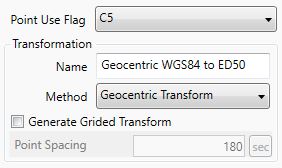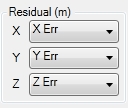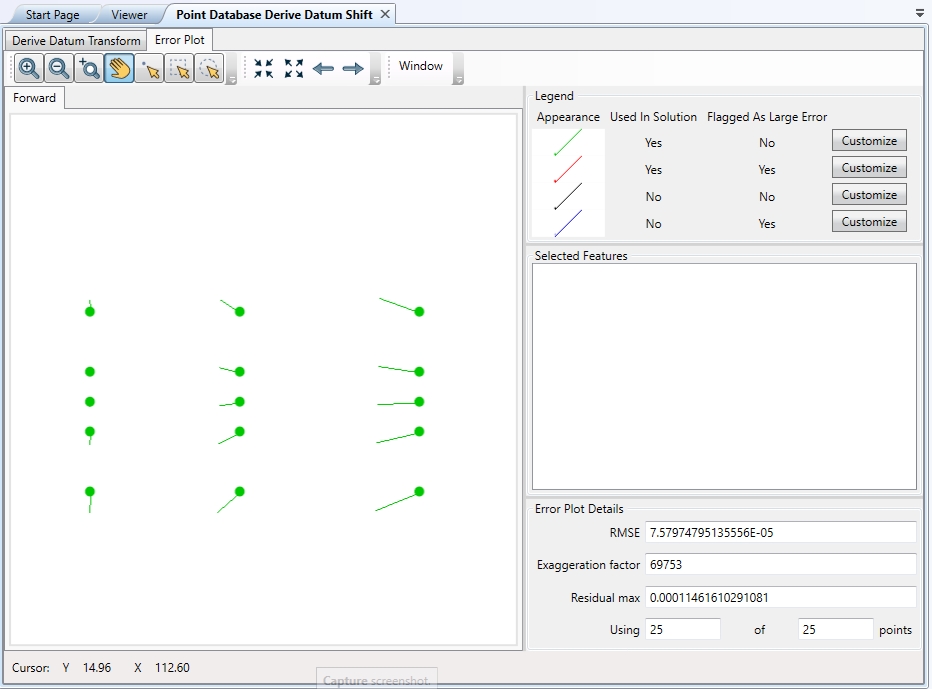 Point
Database Derive Datum Transform
Point
Database Derive Datum Transform
To Derive a Datum Transform from a point database file you will need to:
-
Create a new Point Database Derive Datum Transform job by going to File>New>Job>Point Database Derive Datum Transform. You can also select the job from the Start Page and use the option to 'Create Job' or right-click in the Project Manager to select Create New Job > Point Database Derive Datum Transform.
-
Load a point database file by clicking the Browse (...) button in the Input Data area at the top of the job window. You can load data into the table from a file, or from an ODBC database connection. Note that the extension of any custom text file scheme that you have defined will appear within the file type filter list.
-
Select your Input and Output coordinate systems. For the Point Database Derive Datum Transform, the left-hand coordinate system is the system of your source coordinates and the right-hand coordinate system is for your target coordinates.
-
Use the Format buttons to select the display format for your input and output coordinates. This is very important for angular units.
-
Use the Source and Target fields to define the columns of data needed for the Datum Transform.
Input Settings
Source Coordinates - These values should point to the column containing the Latitude and Longitude of your source coordinate system.
Target Coordinates - These values should point to the column containing the Latitude and Longitude of the target coordinate system.

Point Use Flag - Click "Add New Column" to create a column containing a toggle box for each point. Points with checked boxes will be used in the Derive Datum Transform job.
Name - This is the name of the Datum Transform that will be generated in the datasource.
Transform Method - This will define the type of transform that should be generated when the job is run.

- Geocentric Transform - This
will create a three parameter datum transform from the Source system to
the Target system.
- Coordinate Frame Rotation -
This will create a 7 parameter datum transform from the Source system
to the Target system. This is equivalent to a Position Vector Rotation
but will have the opposite sign.
- Position Vector Rotation - This will create a 7 parameter datum transform from the Source system to the Target system. This is equivalent to a Coordinate Frame Rotation but will have the opposite sign.
Generate Gridded Transform - Check this box to generate a gridded transformation. A point spacing will be auto-selected once the source CRS has been selected. Setting a point spacing here will recalculate the auto-selected spacing. Click Process to produce an NTv2 gridded version of the previously defined shift.
Note: Some software packages require either Coordinate Frame Rotation or Position Vector Rotation. Please make sure you are using the correct transform method.
Output Settings
Adjusted Coordinates - These are the calculated target points after the source points have been run through the conversion. These should closely match your target points in a well defined system but are not likely to perfectly match.
Geocentric Residuals- The least squares residual for the control points.

- Geocentric Transform - This
will create a three parameter datum transform from the Source system to
the Target system.
-
Once all the necessary columns are set in the Conversion Settings dialog, click OK to close the dialog.
-
Click the Process button to complete the Derive Datum Transform calculation. Clicking on the Error Plot tab will display a graph showing the residual errors created in the transformation process.
Error Plot
The Error Plot can be used to graphically assess the fit of individual points within the model. The relative locations of each control point will be displayed as a point.

The vectors coming off the points are exaggerated by the factor shown at the bottom of the screen. This is to assist you by drawing your attention to points that do not fit: the longer the vector, the worse the fit. To see the actual error associated with a point simply click on that point. The RMSE (Root Mean Square Error) is the overall accuracy of the fit based on the control points included in the fit.
-
If necessary, remove control pairs from the model by changing the value in the Point Use Flag column to a character other than 1. You can then click Calculate again, to generate a new datum transform. Repeat this as needed to adjust the fit model.
-
Organize your new Datum Transform by going to Datasource>Datum Transformation Definitions. All new Datum Transforms will be located at the top level of the Datum Transformations category in the tree view. You can drag and drop individual definitions to an appropriate subcategory or create a new subcategory to put the systems in. When you close the dialog, be sure to click Save to save your changes or they will be lost when you close the Calculator.
To create a Batch of the Point Database Derive Datum Transform job, right-click on the job in the Project Manager and select the 'Batch Add' option. Columns will need to be uniformly formatted in each Point Database to add them to a batch job.